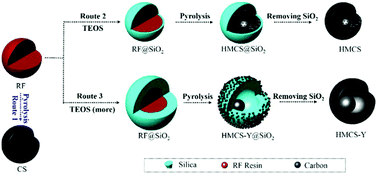A confined space pyrolysis strategy for controlling the structure of hollow mesoporous carbon spheres with high supercapacitor performance†
Abstract
Hollow mesoporous carbon spheres (HMCSs) have been widely used in energy storage due to their high chemical stability, high surface area, thermal insulation, low effective density and high compressive strength. The electrochemical properties of HMCSs are related to their inner structure. In this work, we demonstrate a facile and controllable synthesis of HMCSs with a tunable inner structure by a confined space pyrolysis strategy. In this process, a phenolic resin oligomer solid sphere is coated with a layer of compact silica. The solid resin sphere can be transformed into a HMCS with a hollow or yolk–shell structure by direct annealing treatment in the silica shell. The compact silica shell can provide a confined space for the pyrolysis of the solid phenolic resin, producing carbon spheres with a hollow cavity, abundant mesopores and a high specific surface area without the use of a template agent. Moreover, the amount of silica precursor and the polymerization time of the resin sphere have great influence on the inner structure of the HMCSs. As an electrode material for supercapacitors, HMCSs display excellent performance with a specific capacitance of 352 F g−1 at a current density of 0.5 A g−1, which is promising for high performance energy storage.



 Please wait while we load your content...
Please wait while we load your content...